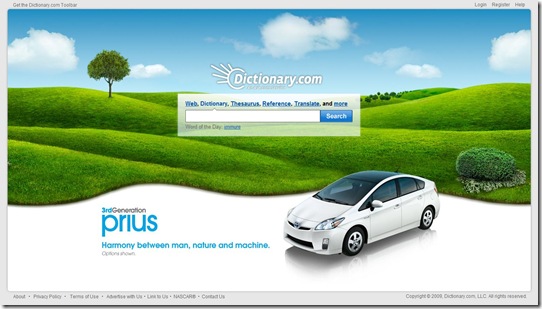Dictionary.com‘s new homepage layout captures what online advertisers have been struggling with since the beginning of the Internet: to advertise effectively without impeding users.
Newspapers have been coping for years with the decline of print circulation. Most people get their news online and newspapers haven’t been able to generate the same level of revenue with their online readers.
Some newspapers (such as the New York Times) use a “paging” system in their articles, forcing the reader to browse through multiple pages to read an article. This generates more ad impressions, which in turn generates more revenue. Nonetheless, the New York Times still faces tough times ahead, mounting tens of millions in losses and hundreds of millions owed in loans. The Huffington Post asks the question “What Will We Do If the New York Times Tanks”.
It’s not as if the New York Times is losing readers. In 2000 the Times’ circulation was around 1 million, while they now enjoy approximately 15 million unique visitors each month. The issue with online advertising is that advertisers aren’t willing to dish out the big cash. Google AdSense for example pays when a user clicks on an ad, but actual ad impressions without clicks generate very little ad revenue.
 My friend Nariman brings up a great point when he says “My eyes are trained to ignore ads; I don’t even see them anymore”. How often do you actually read the little Google “AdWords” advertisements? I know I rarely notice them.
My friend Nariman brings up a great point when he says “My eyes are trained to ignore ads; I don’t even see them anymore”. How often do you actually read the little Google “AdWords” advertisements? I know I rarely notice them.
Does anyone actually look at those ugly horizontal banner ads that some sites still use on the top of the page? Not likely.
That’s why websites are trying to seamlessly integrate ads directly into the layout of the page instead of using polarized ad “sections”. The new Dictionary.com layout is a brilliant example of how an advertisement can be integrated into the site and still be unimposing to the user.
Recall the early days of Flash when advertisers would pop up an ad in your face that forces you to click “close” before you can see the content on the page. If a website does this now, I’ll immediately leave the site because I feel violated.
The new Dictionary.com is next to impossible to ignore, but it’s actually visually appealing and it integrates nicely into the layout and overall design of the page. Could this type of advertising solve the problem newspapers are having with generating revenue?
If a newspaper can figure out how to integrate an ad into the page layout of a newspaper without imposing on the user, then advertisers would be willing to pay much more for ad impressions and it just might solve the cash crunch that newspapers are currently facing.



Good article. I totally agree, both with Nariman and with you. I’ve noticed these new “background” ads as well on certain sites and at first I thought “man, these guys sold themselves out…they changed their entire background!”… but at the end of the day, money = profit = staying in business.
I thought the exact same thing when I saw the Dictionary.com ad and have also felt very compelled by the the Mac ads that interact the top banner with the side box. Its the only time in my life where I recall having ‘watched’ and ad.
I wrote about the ad problem recently as well (post: Victory day) and certainly, your point was very valid in terms of what one could do. I also argue that sites need to focus harder on getting relevant ads. In the dictionary.com one, for example, chances are that a car is very far from your mind when you’re looking up a word and the ad detracts from the value created by the site (and if this ad did well, I contend its because its unique). Now it doesn’t always have to be relative and I understand that its better to take a ad than no ads but we’ve been in this troubling ad game for years now so whatever is being done, its proven to not affective.